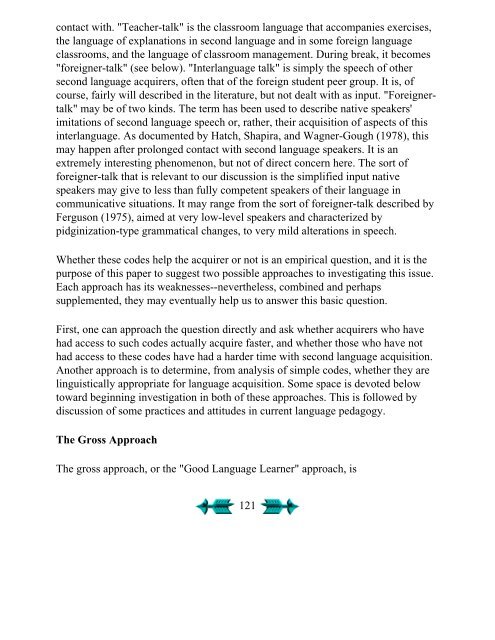Second Language Acquisition and Second ... - Stephen Krashen
Second Language Acquisition and Second ... - Stephen Krashen
Second Language Acquisition and Second ... - Stephen Krashen
Create successful ePaper yourself
Turn your PDF publications into a flip-book with our unique Google optimized e-Paper software.
contact with. "Teacher-talk" is the classroom language that accompanies exercises,<br />
the language of explanations in second language <strong>and</strong> in some foreign language<br />
classrooms, <strong>and</strong> the language of classroom management. During break, it becomes<br />
"foreigner-talk" (see below). "Interlanguage talk" is simply the speech of other<br />
second language acquirers, often that of the foreign student peer group. It is, of<br />
course, fairly will described in the literature, but not dealt with as input. "Foreignertalk"<br />
may be of two kinds. The term has been used to describe native speakers'<br />
imitations of second language speech or, rather, their acquisition of aspects of this<br />
interlanguage. As documented by Hatch, Shapira, <strong>and</strong> Wagner-Gough (1978), this<br />
may happen after prolonged contact with second language speakers. It is an<br />
extremely interesting phenomenon, but not of direct concern here. The sort of<br />
foreigner-talk that is relevant to our discussion is the simplified input native<br />
speakers may give to less than fully competent speakers of their language in<br />
communicative situations. It may range from the sort of foreigner-talk described by<br />
Ferguson (1975), aimed at very low-level speakers <strong>and</strong> characterized by<br />
pidginization-type grammatical changes, to very mild alterations in speech.<br />
Whether these codes help the acquirer or not is an empirical question, <strong>and</strong> it is the<br />
purpose of this paper to suggest two possible approaches to investigating this issue.<br />
Each approach has its weaknesses--nevertheless, combined <strong>and</strong> perhaps<br />
supplemented, they may eventually help us to answer this basic question.<br />
First, one can approach the question directly <strong>and</strong> ask whether acquirers who have<br />
had access to such codes actually acquire faster, <strong>and</strong> whether those who have not<br />
had access to these codes have had a harder time with second language acquisition.<br />
Another approach is to determine, from analysis of simple codes, whether they are<br />
linguistically appropriate for language acquisition. Some space is devoted below<br />
toward beginning investigation in both of these approaches. This is followed by<br />
discussion of some practices <strong>and</strong> attitudes in current language pedagogy.<br />
The Gross Approach<br />
The gross approach, or the "Good <strong>Language</strong> Learner" approach, is<br />
121











